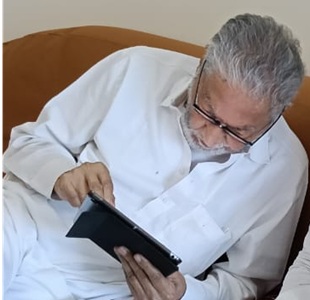The word ‘Urdu’ initially referred to ‘Shahjahanabad’, the walled city of Delhi. This sense became current around the mid-17th century and continued to be in use until the beginning of the 19th century. As the name of a language, the word ‘Urdu’ came to be used for the first time around the very end of the 18th century
ATHER FAROUQUI
Hindi—the original name of the language now known as Urdu—and modern Hindi are two distinct languages. Despite being a fairly new language, notions regarding Urdu’s origins and history are as hotly debated amongst the public at large as among scholars and linguists. Interestingly, the name Urdu gained currency circa 1857, with the formal cessation of Mughal rule. Hindi was the name commonly used until the second decade of the 20th century by none other than Iqbal, a poet whose poetry is overtly Islamic. His use of ‘Hindi’, instead of ‘Urdu’, gives lie to determined efforts, after the establishment of the Muslim League in 1903, to paint Urdu as the language of Muslims, as opposed to modern Hindi as the language of Hindus. Urdu would then be utilised to mobilise Muslim support for a new country.
The publication of Shamsur Rahman Faruqi’s seminal work, Urdu ka Ibtedaee Zamana: Adabi Tarikh o Tahzib ke Pahlu (1999), followed by its original English version (Early Urdu Literary Culture and History [2001]), compelled the revision of many current and honoured notions about early Urdu and its literary culture. In many ways, it was a pioneering work which needs to be revisited. The book demolished myths and assumptions about the early history of the language as it developed in and around Delhi from the late 17th century onwards. It provided new information—not yet challenged—about the origin of the language name ‘Urdu’, and many other aspects of Urdu’s literary history.
It is sad, disappointing, and, most importantly, surprising that most learned Urdu scholars and authorities on Urdu linguistics have not taken the trouble to study the arguments made by Faruqi, or to revise or modify current academic thinking (I believe to be completely wrong, to say the least) on the origin of Urdu as a language name. In scholarship on the language, the reasons why Urdu developed as it did, and the manner in which the organic name of the language ‘Hindi’, earlier called Rekhta as well, was replaced by the spurious language name ‘Urdu’ are undeniably novel, even revolutionary. In fact, currency to ‘Urdu’ as language name may also have been given by enthusiasts of modern Hindi, with the motive of establishing a new language, ‘Hindi’, as opposed to ‘Urdu’, because the word Hindi helps evoke a linguistic–cultural–religious identity. This is explained by the slogan/phrase ‘Hindi–Hindu– Hindustan’, which had sought immediately to establish territories based on nation and religion. This is why the somewhat apologetic nomenclature ‘Adhunik Hindi’ was given up, and Hindi used as language name.
The works currently in vogue on the matter, examined from a refreshingly original standpoint by Faruqi, merely restate age- old misconceptions about the evolution of the Urdu language and literary culture. Yet, these scholars’ ideas are presented as the most authentic statements on the subject and on numerous other issues, which Faruqi has discussed or hinted at in his brief, but extremely compact, book.
Briefly stated, some of Faruqi’s main and revolutionary propositions are as follows:
• The word ‘Urdu’, as language name, has nothing to do with ‘lashkar’ or ‘fauj’ or ‘military camp’, as commonly taught and believed. Urdu was never a pidgin language, comprising a hodgepodge of tongues and dialects developed by Muslim invading armies to enable them to interact with the locals. Even George Abraham Grierson, member of the Indian Civil Service and a linguist who had authored the Linguistic Survey of India, published in 1928, was deceived into believing that Urdu was ‘a mixed language’. Later, he retracted from this position.
• The word ‘Urdu’ initially referred to ‘Shahjahanabad’, the walled city. This sense became current around the mid-17th century and continued to be in use until the beginning of the 19th century.
• As the name of a language, the word ‘Urdu’ came to be used for the first time around the very end of the 18th century.
• Historically, various names were popular for the language now called Urdu. Of them, ‘Urdu’ is the youngest and most suspect—suspect in the sense that it in no way represents anything relating to the origin or nature of the language. ‘Hindi/Hindvi/Dihlavi’ are the earliest names used. The names that were universally popular through the 18th and 19th centuries are ‘Hindi’ and ‘Rekhta’. Examples of the use of ‘Hindi’ to mean what we now call ‘Urdu’ can be found as recently as the early 20th century.
• The word Hindi was commonly used by foreigners to denote the people of India, and any language used locally. Gradually, the most popular language with the name ‘Hindi’ became the name of the language which is now called ‘Urdu’.
• Hindi—as the original name of the language now known as Urdu—and modern Hindi are two distinct languages. Modern Hindi emerged as a political construct in the early 19th century.
• Ironically, modern Hindi has never been the lingua franca of even middle-class Hindus, let alone the Hindu elite. It does not have cultural capital even for those people or sections of Hindu society who claim it as their language for political reasons and identity assertion. This paradox is unique. Modern Hindi is nothing but khari boli shorn of its Arabic and Persian content to the extent possible, and written in the Nagari script.
• Needless to say, whenever Faruqi deployed the word ‘Hindi’ in the traditional context, he meant the language which is now known as Urdu for entirely political reasons.
In Turkish, the word urdu means a ‘horde’. In fact, the English word ‘horde’ is derived from the Turkish urdu. By extension, it may mean ‘a large group of people’, but the word was never used in that sense in the Urdu language. In Mughal India, urdu came to mean a place where the emperor lived—such a place was quite naturally of grand proportions, with a market, and full of all kinds of people, including a large number of camp followers. When Shahjahan built his city—Shahjahanabad—in the mid-17th century (1638–1648) and settled there, the modern-day ‘walled city’ became the permanent ‘urdu-e shahi’, which term came to be used for the place occupied by the royal camp. According to Faruqi, the complete phrase was ‘urdu-e mu’alla-e Shahjahanabad’, and the language spoken there was most commonly Persian, which was called ‘zaban-e urdu-e mu’alla-e Shahjahanabad’. There is a marked difference between ‘camp’ and ‘royal camp’. The deliberate obliteration of the clear distinction between the two led to the distortion of historical facts.
In all likelihood, the term urdu became popular for the royal camp during Akbar’s reign. At no time did Akbar settle in one place after he left Fatehpur Sikri. His royal camp consisted of almost everything—furniture and furnishings, carpets, papers and lighting. There were two sets of everything so that when he decided to move to the next place, courtiers were sent ahead to set up camp in advance. The Persian phrase ‘urdu-e shahi’ appears to have its origin in Akbar’s mobile headquarters.
Started most probably in 1794 or 1795, the project of writing Dariya-e Latafat (The River of Subtleties) was completed in 1807. Its authors, Insha’allah Khan Insha and Muhammad Hasan Qateel, used the word urdu to denote Delhi. This book went unnoticed by scholars, probably on account of its high-flown Persian. First published in 1850, it was never reprinted, and an Urdu translation was made by Pandit Brijmohan Dattatreya Kaifi from an apparently defective printed copy around 1946. The errors that had crept into it at the time of publication were never rectified. Anyone who has read this seminal work cannot fail to see that the authors use ‘urdu’ to denote the city of Shajahanabad.
Mir Amman’s Bagh-o-Bahar (Garden and Spring [1802–1804]), commissioned and produced by the College of Fort William, became a hugely popular work by the mid-1850s and was often prescribed text in schools. Mir Amman clearly mentions at three or four places that he wrote the story in ‘the language of urdu’ (urdu ki zaban). Needless to say, here the word urdu meant Shahjahanabad; it did not denote the name of the language in which the story was written.
Somewhat surprisingly, teachers of the Urdu language and literature failed to understand the simple fact that ‘urdu ki zaban’ denoted ‘the language of the place called urdu’. Urdu usage and grammar do not support the phrase ‘…ki zaban’ to mean ‘the language called …’. It is, of course, common in Persian where, for instance, ‘zaban-e farsi’ translates as ‘the language called Farsi’, and ‘zaban-e inglisi’ ‘the language called English’. Such constructions are found in Urdu, doubtless, never for the language, but the place. This misunderstanding occurred in the 19th century, when Urdu was being used less and less to mean the city of Shahjahanabad. For instance, we do not use ‘bangali ki zaban’ to mean ‘the language called Bengali’. The correct Urdu phrase is ‘bangal [Bengal] ki zaban’.
Originally, Persian was known as ‘zaban-e urdu-e mualla-e Shahjahanabad’. Faruqi explains that when Shah Alam II returned to Delhi in 1771, the use of Hindi (now called Urdu) became popular because of his popularity as a poet and prose writer in the ‘Hindi language’. Shah Alam II’s predilection for Hindi and its universal popularity influenced the speakers of the language so much that Hindi replaced Persian as the zaban-e urdu-e mu’alla-e Shahjahanabad. Gradually, the cumbersome phrase was shortened to urdu-e mu’alla, and finally to Urdu.
John Gilchrist, in his work on ‘Hindi’ grammar (1785), reported that the language commonly known as ‘Rekhta/Hindi’ was also called ‘Oordoo’, or ‘the language of the exalted court’. According to Faruqi, this is the first appearance of ‘Urdu’ as language name. Faruqi in fact states that the works of Mir and Sauda are devoid of the word Urdu as language name. He quotes a couplet by Mushafi to substantiate his stand. Mushafi distinguished ‘Urdu’ from ‘Rekhta’ on the grounds that the word Urdu was never used to mean the Urdu language—it denoted Delhi, and Rekhta denoted the language:
ٰیوعد ںیم ےتخیر ےہ وک یفحصم ہتبلا اک ںابز ہو یک ودرا ںاد ںابز ےہ ہک ینعی
Albatta Mushafi ko hai rekhte mein daawaa Yaani ke hai zabaandaan urdu ki wo zabaan ka
Doubtless, Mushafi has the right to claim mastery of Rekhta, Because he [is] the one fully conversant in the language of Urdu
Quite clearly, ‘Rekhta’ here refers to the language in which Mushafi wrote, and ‘Urdu’ stands for the place where ‘Rekhta’ is spoken. In all likelihood, this couplet was composed somewhere around 1785. Nowhere in the poetic collections of Sauda and Mir does the word occur as language name. The first appearance in poetry of the word Urdu as language name cannot be traced before the verse of Mushafi quoted earlier, which, as pointed out, cannot have been earlier than 1794 because it occurs in the third diwan (poetry collection), the date of compilation of which has been determined as 1209/1794. ‘Urdu’ figures in a few more couplets by Mushafi, but it cannot be said that it has been used as a language name:
ںیم سا یفحصم ےہ ودرا وج اک ےتخیر ہی وت ےن مہ رازہ ںیتاب ںیہ یلاکن یئن
Ye rekhte ka jo urdu hai Mushafi is mein Nai nikali hain baatein hazaar hamne toh
This urdu of Rekhta, Mushafi, in it
I have fashioned a thousand new things
Clearly, the expression ‘rekhte ka jo urdu’ stands for ‘the city of Rekhta’, called Urdu, i.e., Delhi or Shahjahanabad. One can also interpret ‘rekhte ka’ as suggestive of ‘bazaar’. Mushafi died in 1824. Shah Alam II died in 1806 (r. 1759–1806; in Delhi from 1771). Possibly by then, ‘Urdu’ began to mean the Urdu language in preference to Hindi/Rekhta. It is just an assumption, and, even if it is true, it was certainly not in common usage.
One example is that of Asadullah Khan Ghalib (1797–1869), who used Urdu as language name only twice: once in a Persian composition, and once in a letter in Urdu. The Persian composition is undated, but appears to be before 1854. However, it is certainly nowhere as early as the period when Ghalib began composing in Urdu (approximately 1807, certainly around 1811). Around 1850, Ghalib started writing letters in Urdu. But he used the word ‘Urdu’ as language name just once throughout his lifelong Urdu correspondence, and in the masculine: ‘However, my Urdu (mera Urdu) will be far more expressive and idiomatic than that of others.’ Language names are invariably feminine in Urdu, and correct usage as language name would be ‘meri Urdu’. It is obvious that Ghalib’s palpable discomfort with Urdu as a language name led him to unconsciously use the same gender as would apply to a place name. So it is fairly apparent it was not yet popular as a language name.
No significant writer or poet before the 1900s appears to have used Urdu as a language name. Ameer Meenai, among others, has used the word ‘Hindi’ to mean any Indic word, as opposed to Persian. But it is clear that Meenai uses it to mean any Indic word in the literary context. Such usage should not be construed as a linguistic statement conferring a status on modern Hindi as a language separate and independent from modern Urdu.
It is now quite well established that the word ‘Hindi’ was used for two different things. It referred to the languages, people and things belonging to India, as also to Indian dishes and dresses. When this language reached the Deccan, it came to be known as Deccani Hindi and Gujri, Dihlavi, Dakani. Even ‘Rekhta’, borrowed from the north, became popular in the late 18th century. Much before, and sometimes coevally with Hindi/Hindvi/Dihlavi, many local languages of the north—for instance, Braj Bhasha, Awadhi, Bhojpuri, Magadhi, Bundelkhandi and many forms of Rajasthani/ Haryanavi—were producing significant literature (mostly oral). The texts in these languages, if written down, were written in the Persian script. By the time modern Hindi in the Devanagari (or Nagari) script was established as a separate language, many texts in local languages had already been transcribed into the Persian or even the Nagari script. Some remained untranscribed for a long time.
All these local languages and their texts were incorporated into modern Hindi and served to expand its territory, swelling the number of modern Hindi speakers. Vijay Dan Detha, the outstanding Rajasthani–Hindi writer of modern times, died complaining that politics forced him to write in a language named Hindi, where he was obliged to make concessions to modern Hindi, and thus he was deprived of the privilege of calling himself a writer in his native Rajasthani language.
Regrettably, by the late 19th century, Rekhta/‘Hindi’/Urdu came to be identified with Muslims. The initiative in this matter seems to have come from the College of Fort William in the early 19th century. It might have been part of a divisive colonial political agenda, or pure accident. At a conference, the late Stuart McGregor once informed Faruqi that ‘a need was felt’ for the Hindus to have a language of their own. Tara Chand, eminent historian and cultural linguist, does not attribute any motive to the move initiated at Fort William, but clearly states that the idea was to create a new language, written in the Devanagari script and shorn of all its Persian–Arabic vocabulary.
Unfortunately, Muslims too fell into the trap of Urdu=Muslim and Hindi=Hindu. Some of this hardening took place also because of the hegemonic role that Delhi tried to play over Urdu, largely succeeding in occupying centre stage in the forums of various registers of Urdu then more or less in vogue. Lucknow set itself up as an alternate centre, but the net result was a kind of uneasy sharing of centre stage by both Delhi and Lucknow.
Urdu speakers suffered marginalisation, followed by alienation after Partition. The slogan ‘Hindu–Hindi–Hindustani’ was concocted in the early part of the 20th century and this helped reinforce the specious belief that Hindi was the language of Hindus and Urdu was, or ought to be, the language of Muslims.
Tragically, no one—Hindu or Muslim—opposed the spurious name Urdu for the language then called Hindi/Rekhta. Public opinion in India at that time was not at all conscious, even dimly, of the consequences of this new baptism. A large number of Muslims, and some Hindus, opposed the creation of Hindi as a new language, but the matter rapidly became politicised.
Syed Ahmad Khan and large numbers of his followers opposed the introduction of the same language in the Devanagari script with Sanskrit words. Khan was then a social reformer through education—not a linguist—and his focus was mostly on the economic consequences of the step. The loss, in terms of language and linguistic culture, seems not to have been visualised then.






0 Comments